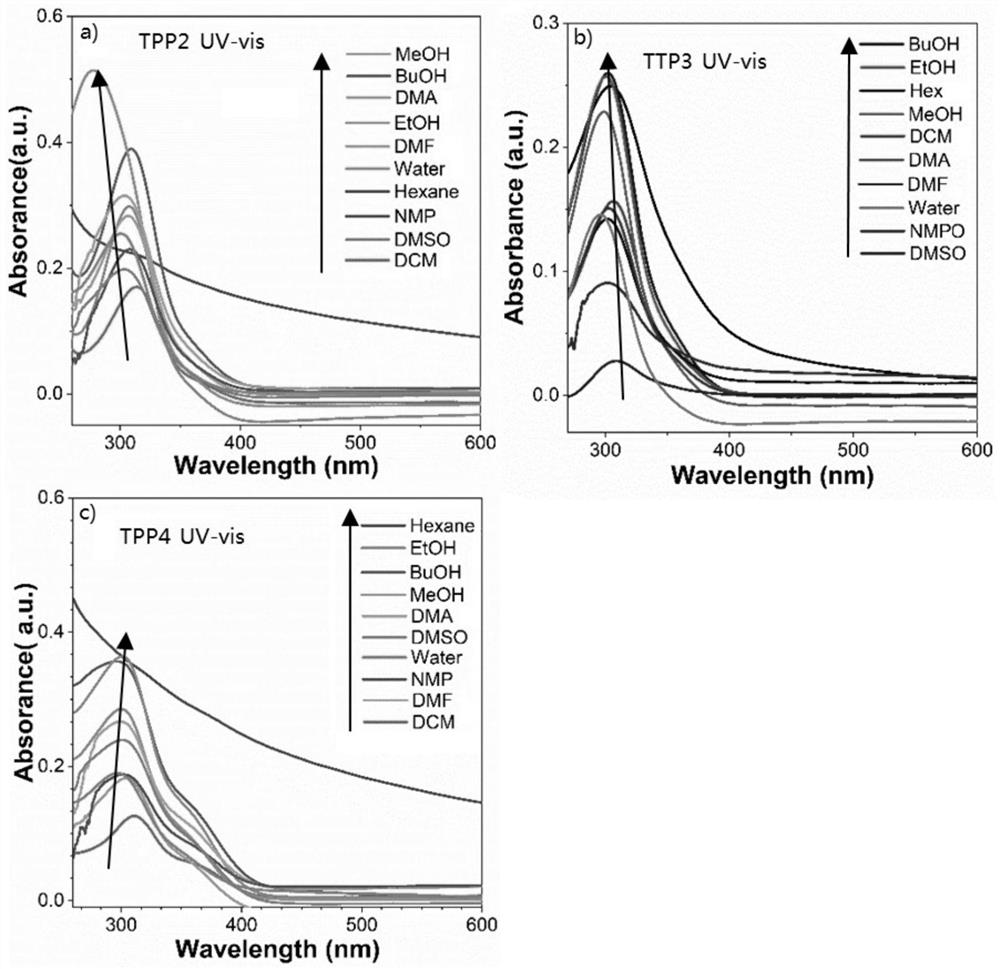Polarity-sensitive triphenyl pyridinium fluorescent probe as well as preparation and application thereof
A technology of triphenylpyridinium salt and fluorescent probe, which is applied in the field of fluorescent sensors, can solve the problems of weakening fluorescence intensity and changing luminescence wavelength, and achieve the effects of weakening fluorescence intensity and reducing quantum yield
- Summary
- Abstract
- Description
- Claims
- Application Information
AI Technical Summary
Problems solved by technology
Method used
Image
Examples
preparation example Construction
[0031] The embodiment of the present invention provides a method for preparing a polarity-sensitive triphenylpyridinium salt fluorescent probe as described above, according to the reaction formula Include steps:
[0032] A. Under an inert atmosphere, (E)-1-(4-methoxyphenyl)-3-phenylprop-2-en-1-one, containing R 1 Acetophenone and excess boron trifluoride ether carry out the first reaction in the first solvent to obtain the pyryl salt intermediate;
[0033] The containing R 1 Acetophenone is R 1 Is H, halogen atom or methoxy group; pyryl salt intermediate is
[0034] B. Under an inert atmosphere, pyryl salt intermediates and R-containing 2 The amine compound is subjected to a second reaction in a second solvent to obtain a fluorescent probe;
[0035] The containing R 2 The amine compound is R 2 -NH 2 , R 2 is an alkyl or substituted alkyl.
[0036] In this example, the preparation method of the triphenylpyridinium salt fluorescent probe is simple, easy to operate...
Embodiment 1
[0045] The preparation of embodiment 1 (E)-1-(4-methoxyphenyl)-3-phenylprop-2-en-1-one
[0046] According to the reaction formula Prepare as follows:
[0047] Benzaldehyde (1eq, 3.00g, 28.27mmol) and 4-methoxyacetophenone (1eq, 4.25g, 28.27mmol) were dissolved in 200mL of ethanol (EtOH), and 1.13g of NaOH was dissolved in 10mL of water while stirring to form The alkaline solution of the above mixture was added dropwise, then 50 mL of water was added, and the reaction was stirred at room temperature for 5 h, resulting in precipitation. After the reaction, the reaction solution was filtered, the precipitate was collected, and washed with water and cold ethanol to obtain 5.74g (E)-1-(4-methoxyphenyl)-3-phenylprop-2-ene-1 - Ketone, a white solid, yield 85.21%. Its structural identification data are: 1 H NMR (500MHz, CDCl 3 )δ8.04(d,J=8.9Hz,2H),7.80(d,J=15.7Hz,1H),7.65–7.63(m,2H),7.55(d,J=15.7Hz,1H),7.43– 7.38(m,3H),6.98(d,J=8.9,2H),3.88(s,3H). 13 C NMR (125MHz, CDCl 3 )δ1...
Embodiment 2
[0048] Embodiment 2 fluorescent probe (R 1 =Br, R 2 =n-C 5 h 11 ) is prepared according to the reaction formula Prepare as follows:
[0049] (1) Under an argon atmosphere, (E)-1-(4-methoxyphenyl)-3-phenylprop-2-en-1-one (1.00eq, 100mg, 0.42mmol), 4 -Bromoacetophenone (3.0eq, 251mg, 1.259mmol), BF 3 ·Et 2 O (10mL) and dichloromethane (DCM) were mixed, and the reaction mixture was vigorously stirred overnight (about 12h) at 45°C. After the reaction was completed, it was cooled to room temperature; 50mL of diethyl ether (Et 2 O), vigorously stirred to make the pyryl salt intermediate (R 1 =Br) precipitated from the reaction solution, filtered, and washed with Et 2 O washes precipitate, obtains 112mg pyryl salt intermediate (R 1 =Br), the yield was 52.8%.
[0050] (2) Under an argon atmosphere, the pyryl salt intermediate (R 1 =Br) (1.0eq, 500mg, 1.03mmol), 1-amylamine ((1.2eq, 125.03mg, 1.43mmol) and ethanol (15mL) were mixed, and the reaction mixture was heated to 80...
PUM
 Login to View More
Login to View More Abstract
Description
Claims
Application Information
 Login to View More
Login to View More - R&D
- Intellectual Property
- Life Sciences
- Materials
- Tech Scout
- Unparalleled Data Quality
- Higher Quality Content
- 60% Fewer Hallucinations
Browse by: Latest US Patents, China's latest patents, Technical Efficacy Thesaurus, Application Domain, Technology Topic, Popular Technical Reports.
© 2025 PatSnap. All rights reserved.Legal|Privacy policy|Modern Slavery Act Transparency Statement|Sitemap|About US| Contact US: help@patsnap.com



